
- •Розділ 1. Генезис особистості.
- •Моя біографія
- •Read and learn the following words:
- •2. Read and translate the following texts: Kateryna Rybachenko’s biography
- •Student’s biography
- •3. Answer the following questions:
- •Translate the following words into Ukrainian:
- •Rearrange the following biography into the right order:
- •6. Answer the following questions in written form:
- •7. Read and translate the following text:
- •Celine Dion Bio – the early years
- •8. You will need to summarize the information about Celine Dion:
- •Моя родина
- •Read and learn the following words:
- •Look at the family tree and complete the sentences using Ex.1:
- •Read and translate the following text:
- •Answer the following questions:
- •Read Ex.3 again. Fill in the missing words:
- •Choose the correct word to fill the gap in each sentence.
- •Say “True” or “False”:
- •Translate the following dialogues:
- •Give definition to the next words and word combinations.
- •Шлюб і родина
- •1. Read and learn the following words:
- •2. Read and translate the text. Family Life
- •Make up sentences of your own with the following words and expressions in English.
- •7. Read the article. Discus it. Best Age for 'I Do'
- •Зовнішність людини
- •1. Read and learn the following words:
- •2. Read and translate the text. People Around the World
- •3. Answer the following questions
- •4. A) Match the descriptions to the people.
- •5. Write the opposites.
- •6. Underline the correct item, then read out the dialogue.
- •7. Read and learn the dialogue.
- •8. Describe 6 pictures.
- •9. Read this extract and make literary translation:
- •10A. Match the adjectives in part a with their fitting opposites in part b.
- •Характер особистості
- •1. Read and learn the following words:
- •2. Read and translate the text. Character
- •Third Type of human character, is phlegmatis.
- •The last characteristic is Koleris,
- •4. Read the job advertisements, then match each person with the job that best suits them.
- •5. You can see a list of some words here. Your task is to find the synonyms. Write only the numbers of the words; like that: 1-3, 2-5 …
- •6. And now find the antonyms.
- •8. Match the character adjectives (1-10) to the descriptions (a-j), then make sentences, as in the example.
- •9. Look at the pictures. Who’s got:-
- •10. Read the article and circle the correct answer for questions 1-6.
- •Мої права та обов’язки
- •Read and learn the following words:
- •Read and translate the following text:
- •Answer the following questions:
- •Translate the following words into Ukrainian. Make up your own sentences with the underlined words:
- •Say “True” or “False”:
- •6. Find the proper definition for the following student’s rights and obligations, then sort them out into two columns: rights obligations
- •7. Translate the following phrases into English:
- •8.Fill in the text with the proper words:
- •Батьки та діти
- •Read and learn the following words:
- •Read and translate the following text:
- •Answer the following questions:
- •Find the appropriate variant of translation:
- •Fill in the text with the proper words and translate it:
- •Read the questionnaire. Discuss in pairs the following points of it:
- •Translate the sentences into English:
- •Make up the sentences of your own with the following words and expressions:
- •Шляхи порозуміння батьків та дітей
- •Read and learn the following words:
- •Read and translate the following text:
- •Tips on How Hard Your Parents May Have It
- •Answer the following questions:
- •Find the appropriate variant of translation:
- •Fill in the text with the proper words and translate it:
- •Are these sentences “True” or “False”:
- •Read the following Internet letter. Discuss the answers in pairs. Choose the best possible answer.
- •8. Translate the following sentences into English:
- •Мій найкращий друг
- •1. Read and learn the following words:
- •2. Read and translate the text. My best friend
- •3. Answer the following questions:
- •Translate the following words into Ukrainian. Make up your own sentences with the underlined words:
- •Read and translate the article and fill in the topic sentences below .
- •Read the topic sentences, then write appropriate supporting sentences.
- •7.. Fill in the text the missing words. Translate.
- •8. Translate into Ukrainian
- •9. Make up your own dialogue in pairs “What does it mean for you to be a good friend?” you may use the following words and word-combinations.
- •Проблеми порозуміння молоді
- •Read and learn the following words:
- •Read and translate the following text:
- •Real Life: Friends
- •Real Life: Dating
- •Look through the text again, and choose the most suitable sentences from the list (a-I) for each gap. There is one extra sentence you do not need to use. Ex.1g.
- •Translate the following phrases into Ukrainian:
- •Fill in the gaps with the proper words:
- •Translate the sentences into English:
- •Розмаїття захоплень сучасної людини
- •Read and learn the following words:
- •The people in pictures 1-4 are all trying to decide what to do this Saturday. Read the short texts about each person, underline the key words:
- •Answer the following questions:
- •Write down two more items in each category:
- •Use the language below to discuss in pairs which activities you and your friend find: exciting, boring, interesting, entertaining, challenging. Why?
- •Look at the pictures. What types of film do you think they are? Choose from the list.
- •In pairs, think of a film you have both seen. Use the expressions and your own ideas to discuss it. Make up a dialogue:
- •What do you like to read? When do you usually read? How much of it is in English?
- •Моє дозвілля
- •Read and learn the following words:
- •Read and translate the text:
- •Read the article again and choose the most suitable sentence from the list (a-I) for each gap. There is one extra sentence which you do not need to use. There is an example at the beginning.
- •Translate the following sentences into English:
- •9. Put in the right order.
- •10. Make composition “How do I spend my leisure time”
- •Мистецтво – засіб формування особистості
- •Read and learn the following words:
- •Read and translate the text: red noses fight poverty
- •Answer the following questions:
- •Find the right translations of the words in bold:
- •Read the text again and complete the summary:
- •Work in pairs. Make up a dialogue. Imagine that one of you is a reporter and the other is involved in Comic Relief. Act out an interview about:
- •Are these sentences “True” or “False”:
- •Translate the following sentences into English:
- •Make up the sentences of your own with the following words:
- •Вплив музики на формування естетичних вподобань
- •1. Read and learn the following words:
- •2. Read and translate the text.
- •3. Say true or false:
- •5. Read and translate the text, fill in the missing words.
- •6. Translate song in writing. The Beatles "Yesterday"
- •8. Put in the right order. Learn the dialogue.
- •9. Translate into English.
- •10. Translate in writing.
- •Різноманіття музичних напрямів
- •1. Read and learn the following words:
- •2. Read and translate the text. Rock music
- •3. Answer the following questions:
- •4. Find the pairs
- •5. Match the words with their translation.
- •6. Find these dates in the text. Say what they are about?
- •7. Translate in writing.
- •Make up sentences with the following words.
- •Translate into English.
- •Живопис як вид мистецтва
- •1. Read and learn the following words:
- •2. Read and translate the text. Painting
- •Materials and Techniques
- •History
- •Say true or false.
- •Match the words with translation.
- •Translate into English. Make up sentences.
- •Put in the right order. Learn the dialogue.
- •8. Read and translate the article Some little known facts about famous paintings
- •9. Make your composition: ‘My favourite Painter.’
- •Шедеври живопису
- •1. Read and learn the following words:
- •2. Read and translate the text. Masterpieces of Art
- •3. Say true or false.
- •4. Find these dates in the text say what they about.
- •5. Match the words.
- •Make up sentences with the following words.
- •7. What’s the word?
- •8. A) Read the article.
- •Interesting to know
- •Найвідоміші галереї світу
- •1. Read and learn the following words:
- •2. Read and translate the text. Galleries
- •3. Answer the following questions:
- •Match the words.
- •Make up sentences of your own with the following words and expressions.
- •8. A) Read and translate the article
- •Спорт як засіб формування характеру
- •Read and learn the following words:
- •Answer the following questions:
- •Look at the pictures. Match the pictures to the names of the extreme sports.
- •A) Which of these qualities should people have in order to do high-risk sports? Discuss in pairs.
- •Read the article and choose the correct answer, a, b, c or d .
- •7. Use the adjectives to act out dialogues, as in the example;
- •8. Fill in the correct word:
- •Match the columns, then, make up sentences:
- •Спорт та дозвілля. Види спорту
- •1. Read and learn the following words:
- •2. Read translate the text. Read Kinds of sport
- •4. Find the pairs
- •5. In what sports or games can you...!
- •6. What units are used for measuring how well sportsmen are doing in these sports and games!
- •7. Fill in the gaps with one of the words from the box below and read the article.
- •8. Put in the right order and learn the dialogue.
- •A game of golf
- •A group of chess enthusiasts had checked into a hotel...
- •President Clinton and his wife are at the first baseball game...
- •Ставлення до занять спортом. Обладнання
- •1. Read and learn the following words:
- •2. Read and translate the text. My Attitude to Sports
- •3. Answer the following questions:
- •4. Translate the passage in writing.
- •5A. Write down six things you can do with a ball. Use your dictionary.
- •7. Match the words given below with their synonyms.
- •8. Make up sentences of your own with the following words.
- •9. Read and translate the article.
- •Подорож як засіб світогляду
- •Read and learn the following words:
- •Read and translate the texts:
- •Answer the following questions:
- •Translate the following words into Ukrainian:
- •These people live in the usa and all trying to choose the holiday.
- •6.Tell the group as many types of holidays as you can in one minute ( package holiday, beach holiday, sailing, etc.)
- •7.Look at the list of items. Which would you put in your suitcase? Shoulder bag?
- •8.Fill in the text with the proper words from Ex.7.
- •Корисна інформація для подорожуючого
- •Read and learn the following words:
- •2. Read and translate the text.
- •Rock Climbing in Malta
- •Ice Diving in the Arctic
- •3. In which holiday(s) (a-d) can you …
- •5. Match the pictures 1-6 with the places a-f from the list.
- •6. Use the clues below to guess what word is in the puzzle. Country and City word Puzzle
- •Types of accomodation
- •7. Match the pictures with the explanation:
- •9. First, match these words and expressions with their explanations.
- •10. Read the article. Before you read, think about these questions.
- •The Brits on holiday
- •Подорож літаком
- •Read and learn the following words:
- •2. Read and translate the text. Travelling by air
- •3. Answer the following questions:
- •5. Find equivalents:
- •6. Read and translate. An air ticket
- •What’s the word?
- •Choose the correct variant.
- •Подорож потягом
- •Read and learn the following words:
- •2. Read and translate the text. Travelling by train
- •3. Answer the following questions:
- •4. Read and translate.
- •5. Can you find 10 words?
- •6. Match the words.
- •Choose the best variant of translation.
- •Fill in the missing words
- •Translate sentences in English.
- •На митниці
- •1. Read and learn the following words:
- •2. Read and translate the text. Ukrainian Customs Declaration
- •3. Answer the questions based on the text:
- •4. Translate the following words and word-combinations into English:
- •5. Translate the dialogues into Ukrainian:
- •6. Translate the sentences into Ukrainian:
- •7. Translate the following words and word-combinations into Ukrainian:
- •Translate and learn the dialogue.
- •Місця які варто відвідати
- •1. Read and learn the following words:
- •2. Read and translate the text.
- •Translate the text in writing. British Museums
- •6.What do you think of painting? Have you got the
- •8. Read and translate the following message. What do you think this woman is? What does she mean?
-
Say true or false.
-
Painting has been freely combined with many other arts, including easel, architecture, and, in the modern era, photography.
-
Among the various media used by artists are vine, watercolour , the pigments ,oil, gouache, tempera , and encaustic.
-
From the age of the baroco, painting tended in the direction of greater intimacy.
-
The greatest masterpieces of Raphael and Michelangelo and of the Florentine masters are generally public works of this character.
-
The same period saw the rise of the large public museums with both temporary and permanent exhibitions, an institution greatly expanded in the 19th cent.
-
People can’t reflect their lives in art.
-
The art of painting in China was linked from the 1st cent.
-
In the Pushkin Museum of Fine Arts in Moscow the art of the Ancient East and Western Europe is represented.
-
Match the words with translation.
A
B
Masterpieces
Мольберт
Application
шедеври
Vehicle
Рідкісний
Representative
Заява
Rare
Засіб пересування, провідник
Easel
Представник
To exist
Розширювати, збільшувати
Expand
Існувати
-
Translate into English. Make up sentences.
|
|
|
|
|
|
|
|
|
-
Put in the right order. Learn the dialogue.
-
That’s a lovely picture?
-
Yes, that is lovely, isn’t it?
-
Beautiful.
-
It’s a Constable, isn’t it?
-
Well it looks like Constable.
-
I suppose so.
-
The last great English painter, wasn’t he?
-
.But they are only minor ones, aren’t they?
-
One can always tell a Constable, can’t one?
-
Well we have had some quite good painters since then
-
I don’t know. Sutherland’s quite famous.
-
But that isn’t everything, is it?
-
No, but it’s something.
-
It’s quality that counts, isn’t it?
-
Well, yes.
-
And English painters aren’t good enough, are they?
-
Well….um…
-
You know I’m right, don’t you?
-
I suppose so.
-
Yes it is, isn’t it?
-
And I like that one over there too.
Describe the paintings.
Think about:
-
Main subject
-
Setting
-
Background
-
Your feelings
|
Describe |
||
|
1)
|
2 |
3 |
8. Read and translate the article Some little known facts about famous paintings
The
original painting by Rembrandt which is now titled “Self Portrait
as the Apostle Paul” was originally 160 cm wide, but unfortunately
the only frame that the Rijksmuseum in Amsterdam had at the time, was
93 cm wide so the curators trimmed off the right-hand s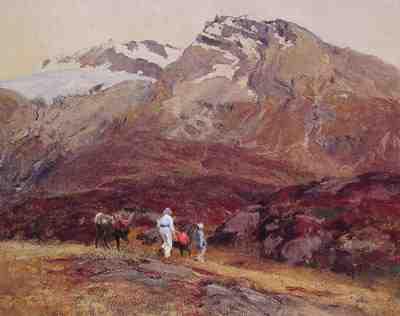 ide
which had a portrait of Rembrandt’s favourite llama which he had
named “Umber”.
ide
which had a portrait of Rembrandt’s favourite llama which he had
named “Umber”.
Another little known fact is that Rembrandt made his own brushes using llama hair from Umber.
This watercolour version of “Coming Down from Mont Blanc” was painted by John Singer Sargent around 1909 and shows a couple of friends bringing Sargent’s pack llamas down the mountain. Sargent was one of the first to use pack llamas to carry his easel and supplies.
I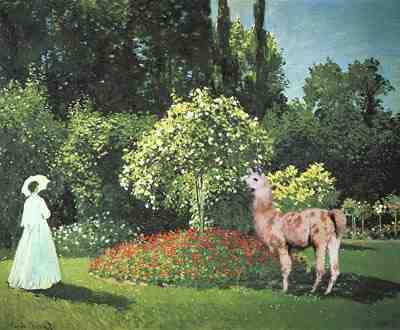 f
you ever get a chance to see the “Oyster Gatherers of Cancale” by
John Singer Sargent in The Corcoran Gallery of Art in Washington, DC,
look very carefully at the left-hand side and you may be able to see
where some llama-hating restorer has carefully painted out the llama.
f
you ever get a chance to see the “Oyster Gatherers of Cancale” by
John Singer Sargent in The Corcoran Gallery of Art in Washington, DC,
look very carefully at the left-hand side and you may be able to see
where some llama-hating restorer has carefully painted out the llama.
Claude
Monet’s painting of “Jeanne-Marguerite Lecadre in the Garden”,
done in 1866, shows one of Claude’s favourite llamas.
V ery
few people know that he kept a few llamas to keep the grass in his
garden trimmed.
ery
few people know that he kept a few llamas to keep the grass in his
garden trimmed.
Salvador
Dali painted many versions of “Persistence of M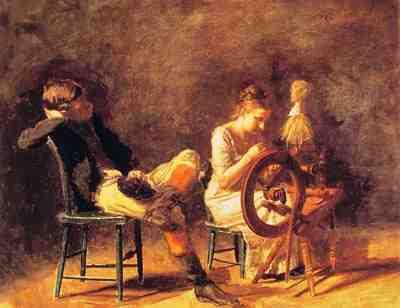 emory”
around 1931 and our favourite one naturally is this one which shows
Salvador Dali’s pet llama which he obviously called “DaliLlama”.
It
is displayed in the Museum of Llama Art in Mount Lehman, British
Columbia.
emory”
around 1931 and our favourite one naturally is this one which shows
Salvador Dali’s pet llama which he obviously called “DaliLlama”.
It
is displayed in the Museum of Llama Art in Mount Lehman, British
Columbia.
Thomas Eakins’ painting of “The Courtship”, done in 1878, obviously doesn’t have a llama in it. However, as shown below, recent x-rays clearly proved that the current painting covered an earlier composition which included two llamas. This would suggest that the girl is probably spinning llama wool.
There
is an on-going controversy now between Eakins scholars and the Fine
Arts Museum of San Francisco whether or not to scrape off the top
layer and reveal the original l lama
painting.
lama
painting.
Whistler’s famous portrait of his mother shows a painting on the wall. Few people realize that it is one of his mother’s favourite paintings. It was done by Whistler three years earlier when he took a trip to Nepal.
On the close-up you can see that the smaller painting has a figure with a pack llama hiking on a ridge with Mount Everest in the background.
O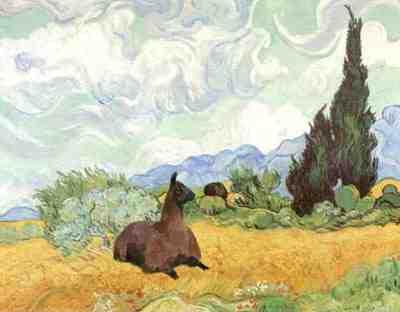 n
close inspection of this Vincent Van Gogh painting of a llama in a
wheat field, you will notice that Mr. Van Gogh has cut off one of the
llama’s ears.
n
close inspection of this Vincent Van Gogh painting of a llama in a
wheat field, you will notice that Mr. Van Gogh has cut off one of the
llama’s ears.
In this Monet painting a curious llama is checking out the magpie on the gate. As you can see in the detail below, the llama has snow on its face from leaning through the snow on the fence.

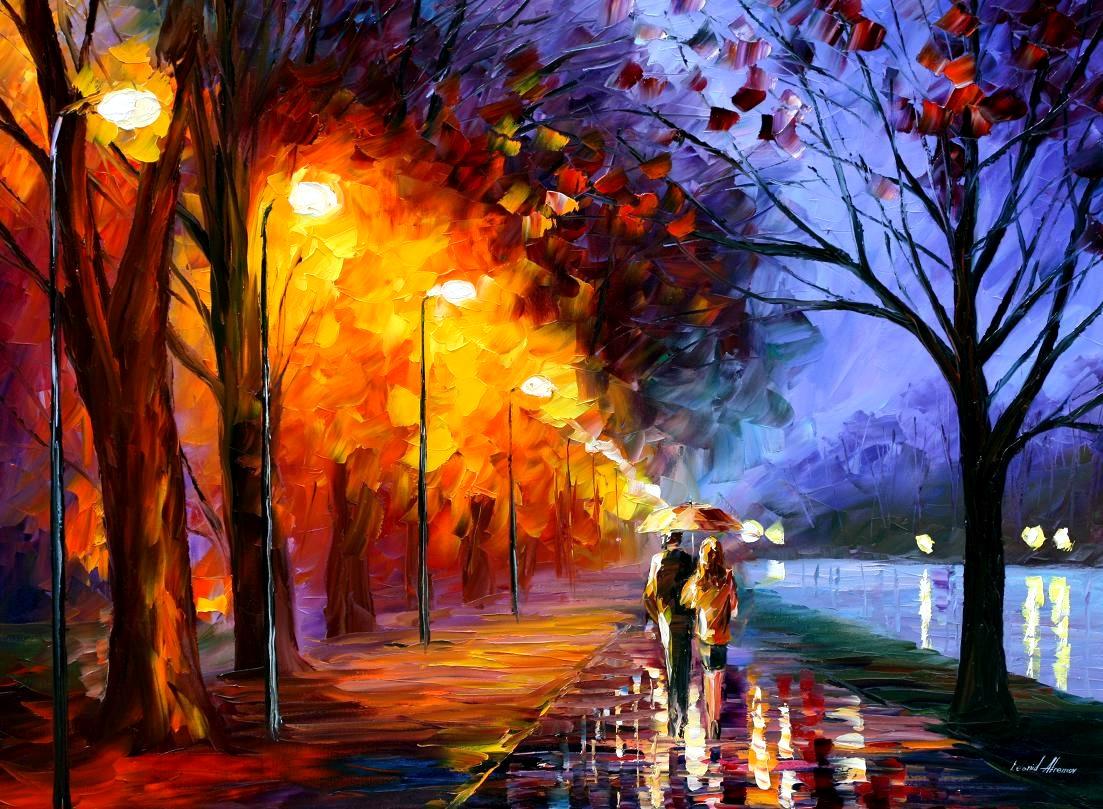
 )
)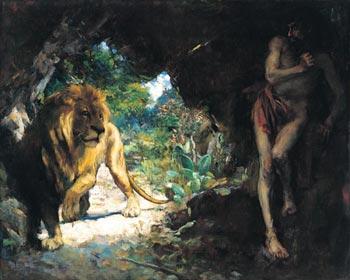 )
)